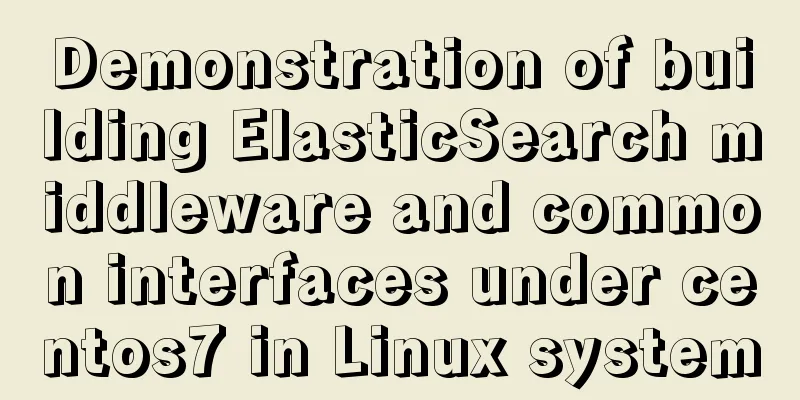Demonstration of building ElasticSearch middleware and common interfaces under centos7 in Linux system

|
1. Introduction to Middleware 1. Basic concepts ElasticSearch is a search server based on Lucene. It provides a distributed multi-user full-text search engine based on a RESTful web interface. Elasticsearch is developed in Java and released as open source under the terms of the Apache license. It is a popular enterprise-level search engine. 2. Distributed Database Distributed database systems usually use smaller computer systems. Each computer can be placed in a separate place. Each computer may have a complete copy of the DBMS, or a partial copy, and has its own local database. Many computers located in different locations are interconnected through a network to form a complete, global, logically centralized, and physically distributed large database. 3. Core Role 1) Nodes and clusters Cluster represents a cluster. There are multiple nodes in the cluster, one of which is the master node. This master node can be generated through election. The master and slave nodes are within the cluster. One of the concepts of es is decentralization, which literally means no central node. This is for the outside of the cluster, because from the outside, the es cluster is logically a whole. A single Elastic instance is called a node. A group of nodes forms a cluster. 2) Shards It stands for index sharding. Elasticsearch can divide a complete index into multiple shards. The advantage of this is that a large index can be split into multiple shards and distributed to different nodes. Constitute a distributed search. The number of shards can only be specified before the index is created and cannot be changed after the index is created. 3) Document 4) Index Elastic will index all fields, and when searching for data, you can directly search the index. The name of each Index (which is understood as the database name) must be lowercase. 5) Type Document can be virtually logically grouped according to Type to filter Document, which is understood as the database table name. 2. Middleware Installation 1. Installation environment and version
2. Download and decompress The download path is in the folder of the current directory, or you can specify the download path. wget -P directory url. wget https://artifacts.elastic.co/downloads/elasticsearch/elasticsearch-6.3.2.zip [root@localhost roo]# mv elasticsearch-6.3.2.zip /usr/local/mysoft/ [root@localhost mysoft]# unzip elasticsearch-6.3.2.zip 3. Start the software [root@localhost mysoft]# cd elasticsearch-6.3.2/ [root@localhost elasticsearch-6.3.2]# ./bin/elasticsearch 1) Report an error org.elasticsearch.bootstrap.StartupException: java.lang.RuntimeException: can not run elasticsearch as root Create new user groups and users [root@localhost]# useradd esroot [root@localhost]# passwd esroot [root@localhost]# groupadd esgroup [root@localhost]# usermod -g esgroup esroot esroot user authorization chown esroot /usr/local/mysoft/elasticsearch-6.3.2 -R Switch to esroot user [root@localhost mysoft]# su - esroot [esroot@localhost ~]$ su #Return to root user 2) Error 2 max file descriptors [4096] for elasticsearch process is too low, increase to at least [65536] Execute the following command, which is performed under Root privileges. [root@localhost roo]# vim /etc/security/limits.conf Add content *soft nofile 65536 * hard nofile 65536 Switch back to the esroot user Restarted, no error message. 4. Open the command line test
curl localhost:9200
[roo@localhost ~]$ curl localhost:9200
{
"name" : "YMS44oi",
"cluster_name" : "elasticsearch",
"cluster_uuid" : "2ZXjBnkJSjieV_k1IWMzrQ",
"version" : {
"number" : "6.3.2",
"build_flavor" : "default",
"build_type" : "zip",
"build_hash" : "053779d",
"build_date" : "2018-07-20T05:20:23.451332Z",
"build_snapshot" : false,
"lucene_version" : "7.3.1",
"minimum_wire_compatibility_version" : "5.6.0",
"minimum_index_compatibility_version" : "5.0.0"
},
"tagline" : "You Know, for Search"
}
In this way, the elasticsearch-6.3.2 environment is successfully built. Request port 9200, and Elastic returns a JSON object containing information such as the current node, cluster, and version. 5. Configure external access By default, Elastic only allows local access. If remote access is required, you can modify the config/elasticsearch.yml file in the Elastic installation directory, uncomment network.host, change its value to 0.0.0.0, and then restart Elastic. [esroot@localhost config]$ cd /usr/local/mysoft/elasticsearch-6.3.2/config [esroot@localhost config]$ vim elasticsearch.yml network.host: 0.0.0.0 6. Install IK Chinese word segmenter Switch to root user [root@localhost elasticsearch-6.3.2]$ ./bin/elasticsearch-plugin install https://github.com/medcl/elasticsearch-analysis-ik/releases/download/v6.3.2/elasticsearch-analysis-ik-6.3.2.zip 3. Getting Started Index creation and deletion 1. Create an index
[esroot@localhost ~]$ curl -X PUT 'localhost:9200/esindex01'
# Return data {
"acknowledged": true,
"shards_acknowledged": true,
"index": "esindex01"
}The server returns a JSON object, and the acknowledged: true field indicates that the operation was successful. 2. Delete the index
[esroot@localhost ~]$ curl -X DELETE 'localhost:9200/esindex01'
{"acknowledged":true}acknowledged: A true field indicates that the operation was successful. 4. Source code address GitHub address: Cicadasmile https://github.com/cicadasmile Code Cloud Address: Cicadasmile https://gitee.com/cicadasmile Summarize The above is a demonstration of building ElasticSearch middleware and common interfaces under centos7 under Linux system introduced by the editor. I hope it will be helpful to everyone. If you have any questions, please leave me a message and the editor will reply to you in time. I would also like to thank everyone for their support of the 123WORDPRESS.COM website! You may also be interested in:
|
<<: Detailed explanation of the execution plan explain command example in MySQL
>>: Vue improves page response speed through lazy loading
Recommend
Detailed steps to delete environment variables in Linux
How to delete environment variables in Linux? Use...
Vue implements a simple timer component
When doing a project, it is inevitable to encount...
Dynamically edit data in Layui table row
Table of contents Preface Style Function Descript...
Installation and configuration tutorial of MySQL 8.0.16 under Win10
1. Unzip MySQL 8.0.16 The dada folder and my.ini ...
mysql startup failure problem and scenario analysis
1. One-stop solution 1. Problem analysis and loca...
10 excellent Web UI libraries/frameworks
1. IT Mill Toolkit IT Mill Toolkit is an open sou...
Tutorial on installing JDK Tomcat MySQL on Linux (remote access using Mac)
One environment Alibaba Cloud Server: CentOS 7.4 ...
Rounding operation of datetime field in MySQL
Table of contents Preface 1. Background 2. Simula...
Install mysql offline using rpm under centos 6.4
Use the rpm installation package to install mysql...
How to use CSS styles and selectors
Three ways to use CSS in HTML: 1. Inline style: s...
Example code for text origami effect using CSS3
Preface This article mainly shares with you an ex...
Usage of Vue filters and timestamp conversion issues
Table of contents 1. Quickly recognize the concep...
Web page image optimization tools and usage tips sharing
As a basic element of a web page, images are one ...
The visual design path of the website should conform to user habits
Cooper talked about the user's visual path, w...
A brief discussion on the understanding of TypeScript index signatures
Table of contents 1. What is an index signature? ...









